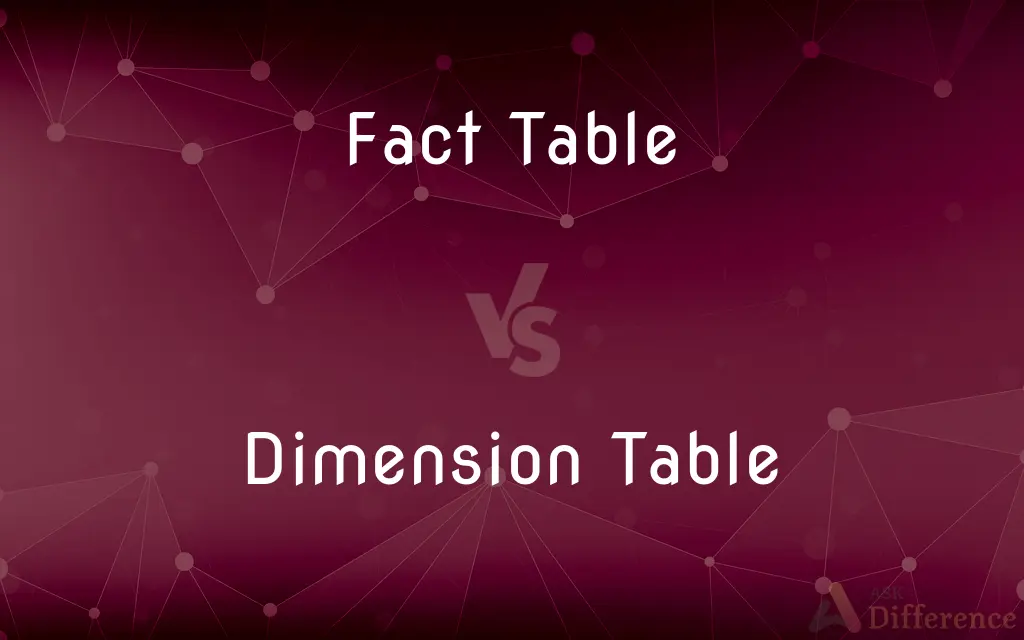Fact Table vs. Dimension Table — What's the Difference?
By Tayyaba Rehman — Published on January 11, 2024
A Fact Table in data warehousing contains quantitative data for analysis, while a Dimension Table stores descriptive attributes to contextualize fact data.

Difference Between Fact Table and Dimension Table
Table of Contents
ADVERTISEMENT
Key Differences
Fact Tables and Dimension Tables are key components of a star schema in data warehousing. A Fact Table contains measurable, quantitative data that businesses want to analyze, such as sales amounts or transaction volumes. In contrast, a Dimension Table holds descriptive attributes related to the fact data, which helps in providing context to the facts, like customer names, product descriptions, or geographical locations.
Fact Tables typically have a large number of records and contain foreign keys that link to associated Dimension Tables. These keys enable the fact data to be analyzed in various dimensions. Dimension Tables are usually smaller and contain detailed information about each dimension, making the data in Fact Tables understandable and actionable.
The data in a Fact Table is generally numeric and additive, allowing for operations like summation and averaging across various dimensions. Dimension Tables, on the other hand, primarily consist of text fields and sometimes hierarchical information, like categories and subcategories.
A key characteristic of Fact Tables is that they often have a composite primary key made up of several foreign keys from the Dimension Tables. In Dimension Tables, the primary key is typically a single unique identifier for each dimension record.
In terms of update frequency, Fact Tables are regularly updated as new transactions occur. Dimension Tables are less frequently updated but can evolve over time to reflect changes in the business environment, like adding new products or changing geographical regions.
ADVERTISEMENT
Comparison Chart
Data Content
Quantitative data, e.g., sales, costs
Descriptive attributes, e.g., names, categories
Table Size
Generally large with many records
Smaller with detailed information
Primary Key
Composite key from Dimension Tables
Single unique identifier
Update Frequency
Regularly updated with new transactions
Less frequently updated
Role in Analysis
Analyzed for business metrics
Provides context to Fact Table data
Compare with Definitions
Fact Table
Often has a composite primary key linked to Dimension Tables.
The primary key in our Fact Table includes date, product ID, and store ID.
Dimension Table
Updated less frequently, reflecting changes in business dimensions.
When new products are launched, the product Dimension Table is updated.
Fact Table
Central table in a star schema of a data warehouse.
The Fact Table is at the center of our data warehouse, linked to various dimensions.
Dimension Table
Contains descriptive attributes to understand fact data.
Our product Dimension Table includes names, categories, and descriptions.
Fact Table
Contains measurable, transactional data.
In the Fact Table, each row represents a unique sale.
Dimension Table
Provides detailed information on each dimension.
The time Dimension Table breaks down dates into days, months, and years.
Fact Table
A Fact Table holds quantitative data for analysis.
The company's Fact Table contains all its sales transaction data.
Dimension Table
Has a unique identifier for each record.
Each record in the geographical Dimension Table has a unique region code.
Fact Table
Updated frequently with new transaction data.
Daily sales data is constantly added to the Fact Table.
Dimension Table
A Dimension Table stores contextual information for Fact Tables.
The customer Dimension Table holds information about each customer.
Common Curiosities
What does a Dimension Table store?
It stores descriptive details that provide context to the data in Fact Tables.
What is a Fact Table in data warehousing?
It's a table that contains the core data for analysis, usually in numeric form.
Why are Fact Tables important in business analysis?
They provide the measurable data needed for calculating key performance indicators and metrics.
How often is data in a Fact Table updated?
It's updated regularly as new transactions or events occur.
How are Fact Tables and Dimension Tables linked?
They are linked through foreign keys in the Fact Table that reference primary keys in the Dimension Tables.
How do Fact Tables support business decision-making?
They provide the quantitative basis for analyzing business performance and trends.
Can a Dimension Table exist without a Fact Table?
While possible, Dimension Tables are typically designed to complement Fact Tables in a data warehouse.
What kind of data is typically found in a Dimension Table?
It includes descriptive attributes like names, addresses, product descriptions, or time periods.
Is it possible to have multiple Fact Tables linked to a Dimension Table?
Yes, multiple Fact Tables can be linked to a single Dimension Table.
Can Dimension Tables contain numeric data?
While they primarily contain descriptive data, they can also include numeric identifiers or hierarchical data.
Why are Dimension Tables crucial for data reporting?
They allow for the meaningful grouping and categorization of data during reporting and analysis.
Are Fact Tables larger than Dimension Tables?
Generally, yes, as they contain transactional data that accumulates over time.
Are Fact Tables used in every data warehouse?
Most data warehouses use Fact Tables as they are central to the star schema architecture.
What is an example of a composite primary key in a Fact Table?
A composite key might include a combination of date, product ID, and store ID.
How does a Dimension Table enhance data analysis?
It provides the necessary context and details to make sense of the numbers in the Fact Tables.
Share Your Discovery

Previous Comparison
Protozoans vs. Metazoans
Next Comparison
Interrogative Pronoun vs. Interrogative AdjectiveAuthor Spotlight
Written by
Tayyaba RehmanTayyaba Rehman is a distinguished writer, currently serving as a primary contributor to askdifference.com. As a researcher in semantics and etymology, Tayyaba's passion for the complexity of languages and their distinctions has found a perfect home on the platform. Tayyaba delves into the intricacies of language, distinguishing between commonly confused words and phrases, thereby providing clarity for readers worldwide.












































